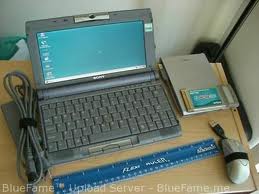 |
| My laptop Your Laptop |
End of 2008, for the first time in history, laptop sales surpassed desktop sales.
Dynabook
Alan Key in 1968 to design a prototype of what he called "PC for children of all ages". Kay wanted to create a portable computer that thin, weighing about 1 kg, and has a screen that size is approaching the size of the paper. (Kay mentions that he needs a screen with 1 million pixels.)
Less lucky, the technology required to produce this tool was not developed at that time. So Kay's vision of the Dynabook can not be realized.
Portable Teletype
40 years ago, a computer filled a room size, and has a lower processor capabilities than smartphones now. Nevertheless, the dream of a portable computer is already there.
March 1968 is not possible to carry a computer, but ketiknya tool can be made portable. That is a Teletype interface, artificial KSR-33 Teletype Corporation.
This tool is used to send what was typed from one location to the Teletype machines in other locations as far apart. It weighs about 30 kg. You can watch a video about the KSR-33 on YouTube.
Osborne 1
In 1981, the first portable computers eventually emerge. Osborne Computer Corp. computer maker, designed the Osborne 1. This portable computer has a screen with a diagonal 5 ", and has a bag carriers.
This machine has two disks for a floppy-disk drives. It cost $ 1,795 including software and weighs about 10 kg.
Grid Compass 1100
This portable computer is the first to use the fold, namely using clam-shell technique. Originally designed for NASA, and made available to general consumers in 1982.
Grid Compass 1100 weighs 5.5 kg, with 340KB of memory. It cost $ 8,000 including software and maintenance agreements (some sort of warranty).
But these machines do not last long in the market, because it is not compatible with IBM. (At that time the popular IBM PC compatible.)
IBM PC Convertible
In 1985, many observers wondered whether the technology concept of the laptop will last a long time. In an article in the New York Times, Erik Sandberg-Diment question "what is happening with the laptop?" Once he saw a reduction in the number of laptop usage in Comdex computer exhibition since 1983 to 1985.
But in 1986, IBM introduced the IBM PC Convertible sold in the market. With a price of $ 1995, this laptop is the first laptops successful on the market. And is the first IBM machine that uses a disk drive to a floppy-disk size of 3.5 ".
It weighs 5.5 kg and has a 256KB memory. There are two disk drives, use the LCD screen, a parallel port for printers, and basic software.
Compaq SLT/286
October 1988, Compaq made its debut with SLT/286. The first portable computer that uses a VGA screen (640 x 480 pixels).
Weighing 6.3 kg, with a 20MB hard drive, 12MHz processor. The keyboard can be removed from the body of the laptop. This is the first portable computer that is compact enough to carry in flight.
Apple PowerBook 100
The next leap after Compaq SLT/286 is Apple PowerBook 100, which appeared in 1991. This laptop is made by Sony for Apple, and use the trackball as a mouse replacement.
This laptop has a palm rest (armrest) for convenience. Then the palm rest became a standard feature for all laptops.
PowerBook 100 using 16MHz processor, 16 bit CPU and 2MB RAM (which can be expanded up to 8MB). 20MB of hard disk, screen 640x480 pixel passive-matrix, and a mono speaker. It weighs about 7 kg, and the price is $ 2500.
IBM ThinkPad
 In late 1992, IBM mimic a compact design with the introduction of the PowerBook series ThinPad IBM. The most famous version is the ThinkPad 700C, using Windows 3.1 operating system, and has a 120MB HDD.
In late 1992, IBM mimic a compact design with the introduction of the PowerBook series ThinPad IBM. The most famous version is the ThinkPad 700C, using Windows 3.1 operating system, and has a 120MB HDD.Using an Intel CPU 486SLC 25MHz. Active-matrix TFT screen is 10.4 ". For pointing, used little red sticks.
Apple PowerBook 500
In 1988, George Gerpheide found the touchpad on the capacitance. But this technology has not yet appeared on the laptop until 1994. Apple PowerBook 500 was the first to use the touchpad. Apple calls it the trackpad, which is immediately followed by another vendor.
PowerBook 500 Series consists of four models: 520, 520c, 540 and basically wear 540c.Spesifikasi 25MHz processor, 4MB RAM (36MB maximum), the screen is 9.5 ". HDDs up to 320MB, the size is pretty amazing for that period.
Toshiba Portege T3400
One and a half years before the appearance of Windows 95, early 1994, Toshiba came with its first laptop. There are two models in the Portege T3400 series, namely monochrome screen for $ 2599, and active-matrix color screen for $ 3900. Both use Windows 3.1
Toshiba advertise it as a subnotebook, with the sleek look, and gray are fashionable. Battery wear a high-power lithium ion, referred to that time as the cutting edge of mobile energy technology. T3400 can switched on for 6 hours. Battery can be recharged for 3 hours to full in a state of the machine is turned off, or as long as 80-10 hours if in a state of life.
Intel 486SX processor used, with 4MB RAM (20MB max), and 120MB HDD. This laptop also has a PCMCIA slot for extra memory. It weighs 1.8 kg.
Panasonic Toughbook CF-25
In 1996, when most computer makers led to a model of a leaner and faster, trying to make the Panasonic laptop layered thick and break-resistance. The result is a Toughbook CF-25, the first model from Panasonic Toughbook solid (which still continues to this day).
CF-25 is designed to withstand falls from a height of 2 feet (about 60 cm or as high as a table) and immune to dust and moisture resistant. The first model Toughbook wearing aluminum alloy casing.
Intel Pentium I 166Mhz processor, with a maximum of 96MB of RAM, and 1GB HDD. This laptop is suitable for use in harsh environments such as battlefields.
Apple iBook G3
Apple iBook G3 is one of the innovative ideas from Steve Jobs. At Macworld Expo in New York in 1999, Steve Jobs wowed everyone when brought to the stage and put the iBook to surf the Internet.
That's the first laptop that uses wireless-card. Jobs claimed G3 portable computer as the second fastest in the world. The first one he claims is the fastest Apple PowerBook.
Apple iBook G3 also comes with colorful refreshing.
Sony PictureBook
Apple is stunningly beautiful world with style and wireless networking. But the iSight camera that is now in the MacBook, first appeared on a laptop with Windows 98. In 1999, Sony launched the VAIO C1 PictureBook with a price of $ 2299.
VAIO laptop weighs 1.4 kg. Quite compact and has a bult-in camera that can record still images and moving video to 60 seconds.
PictureBook is also the beginning of what is now (a decade later) is known as netbooks. Its thickness is only 1.45 ", and do not use either an external floppy drive or CD-ROM.
XO OLPC (one laptop per child)
Asus Eee PC netbook is widely known as an innovation in late 2007. But, in 2005, long before the advent of the Asus Eee, has introduced the concept of Nicholas Negroponte $ 100 laptop at the World Economic Forum (a non-profit Swiss foundation) in Davoz, Switzerland.
Negroponte's dream is gradually becoming XO OLPC (one laptop per child) with Internet access capabilities that are sold at a price of $ 200. When the OLPC XO offers give-one/get-one scheme in late 2007, the enthusiasm for further soared this computer.
Intel and Microsoft quickly followed the path XO, super-cheap and super-portable. Then a sudden netbook into a very fast growing segment in the computer market.
Apple MacBook Air
The early 21st century, the laptop started to become much faster, with a large HDD sizes and better graphics capabilities. In the third quarter of 2008, for the first time in the history of laptop sales surpassed desktop sales.
Early 2008, Apple launched the Apple MacBook Air. Previously, in 2004 Sony VAIO X505 is a laptop with impressive achievements with thinness and lightness. But the MacBook Air comes with the idea of "how thin a computer". With the new Intel chips and non-removable battery, but no optical drive, water became a star at Macworld 2008.
TechCrunch CrunchPad
Web tablets will likely be the next evolutionary stage in the world of portable computers. Such tablets are not yet very developed, but at least there are real products, such as artificial TechCrunch CrunchPad.
These tools form a Web tablet with Linux OS (custom built), and using the Intel Atom chipset. Has two USB ports, Webcam and mic.


























